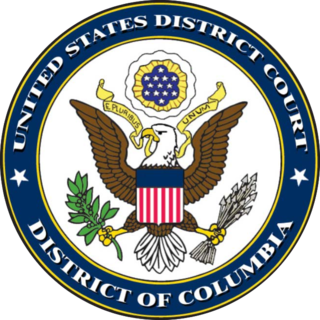
The Grand Staircase–Escalante National Monument (GSENM) is a United States national monument protecting the Grand Staircase, the Kaiparowits Plateau, and the Canyons of the Escalante in southern Utah. It was established in 1996 by President Bill Clinton under the authority of the Antiquities Act with 1.7 million acres of land, later expanded to 1,880,461 acres (7,610 km2). In 2017, the monument's size was reduced by half in a succeeding presidential proclamation, and it was restored in 2021. The land is among the most remote in the country; it was the last to be mapped in the contiguous United States.

In the United States, a national monument is a protected area that can be created from any land owned or controlled by the federal government by proclamation of the president of the United States or an act of Congress. National monuments protect a wide variety of natural and historic resources, including sites of geologic, marine, archaeological, and cultural importance. In contrast, national parks in the U.S. must be created by Congressional legislation. Some national monuments were first created by presidential action and later designated as national parks by congressional approval.

The Antiquities Act of 1906, is an act that was passed by the United States Congress and signed into law by Theodore Roosevelt on June 8, 1906. This law gives the president of the United States the authority to, by presidential proclamation, create national monuments from federal lands to protect significant natural, cultural, or scientific features. The Act has been used more than a hundred times since its enactment.
The Nonintercourse Act is the collective name given to six statutes passed by the United States Congress in 1790, 1793, 1796, 1799, 1802, and 1834 to set Amerindian boundaries of reservations. The various acts were also intended to regulate commerce between settlers and the natives. The most notable provisions of the act regulate the inalienability of aboriginal title in the United States, a continuing source of litigation for almost 200 years. The prohibition on purchases of Indian lands without the approval of the federal government has its origins in the Royal Proclamation of 1763 and the Confederation Congress Proclamation of 1783.

Gladys Kessler was a United States district judge of the District Court for the District of Columbia.

The New England Seamounts is a chain of over twenty underwater extinct volcanic mountains known as seamounts. This chain is located off the coast of Massachusetts in the Atlantic Ocean and extends over 1,000 km from the edge of Georges Bank. Many of the peaks of these mountains rise over 4,000 m from the seabed. The New England Seamounts chain is the longest such chain in the North Atlantic and is home to a diverse range of deep sea fauna. Scientists have visited the chain on various occasions to survey the geologic makeup and biota of the region. The chain is part of the Great Meteor hotspot track and was formed by the movement of the North American Plate over the New England hotspot. The oldest volcanoes that were formed by the same hotspot are northwest of Hudson Bay, Canada. Part of the seamount chain is protected by Northeast Canyons and Seamounts Marine National Monument.
Shafiq Rasul, Asif Iqbal, Ruhal Ahmed, and Jamal Al-Harith, four former Guantánamo Bay detainees, filed suit in 2004 in the United States District Court in Washington, DC against former Secretary of Defense Donald Rumsfeld. They charged that illegal interrogation tactics were permitted to be used against them by Secretary Rumsfeld and the military chain of command. The plaintiffs each sought seek compensatory damages for torture and arbitrary detention while being held at Guantánamo.

The Guantanamo Bay Hunger Strikes were a series of prisoner protests at the U.S. detention camp Guantanamo Bay in Cuba. The first hunger strikes began in 2002 when the camp first opened, but the secrecy of the camp's operations prevented news of those strikes from reaching the public. The first widely reported hunger strikes occurred in 2005.

Cayuga Indian Nation of New York v. Pataki, 413 F.3d 266, is an important precedent in the United States Court of Appeals for the Second Circuit for the litigation of aboriginal title in the United States. Applying the U.S. Supreme Court's recent ruling in City of Sherrill v. Oneida Indian Nation of New York (2005), a divided panel held that the equitable doctrine of laches bars all tribal land claims sounding in ejectment or trespass, for both tribal plaintiffs and the federal government as plaintiff-intervenor.

Barclays Capital Inc. v. Theflyonthewall.com, Inc., 650 F.3d 876, was a case decided in the United States Court of Appeals for the Second Circuit where the Second Circuit, reversing the decision of the US District Court below it, found that the claims of three major financial investment firms against an internet subscription stock news service (theflyonthewall.com) for "Hot-news" Misappropriation under state common law doctrine could not stand, as they were pre-empted by several sections of the Federal Copyright Act.
Jung v. Association of American Medical Colleges was an antitrust class-action lawsuit that alleged collusion to prevent American trainee doctors from negotiating for better working conditions. The working conditions of medical residents often involved 80- to 100-hour workweeks. The suit had some early success but failed when the US Congress enacted a statute exempting matching programs from federal antitrust laws.

The Northeast Canyons and Seamounts Marine National Monument is a marine national monument of the United States off the coast of New England, on the seaward edge of Georges Bank. It was created by President Barack Obama on September 15, 2016, as the first U.S. marine national monument in the Atlantic Ocean.

The Marine Policy of the Barack Obama administration comprises several significant environmental policy decisions for the oceans made during his two terms in office from 2009 to 2017. By executive action, US President Barack Obama increased fourfold the amount of protected marine space in waters under United States control, setting a major precedent for global ocean conservation. Using the U.S. president's authority under the Antiquities Act of 1906, he expanded to 200 nautical miles the seaward limits of Papahānaumokuākea Marine National Monument in Hawaiʻi and the Pacific Remote Islands Marine National Monument around the U.S. island possessions in the Central Pacific. In the Atlantic, Obama created the Northeast Canyons and Seamounts Marine National Monument, the first marine monument in the U.S. exclusive economic zone (EEZ) in the Atlantic.

Executive Order 13792, entitled "Review of Designations Under the Antiquities Act," is an executive order issued by US President Donald Trump on April 26, 2017, that directed the Secretary of the Interior to review designations of national monuments made since 1996. The order applies to all new monuments greater than 100,000 acres in size and monuments that were expanded by at least 100,000 acres. Twenty-two land monuments and five marine monuments that were created by the administrations of Bill Clinton, George W. Bush, and Barack Obama were subject to review.

Citizens for Responsibility and Ethics in Washington and National Security Archive v. Trump and EOP, No. 1:17-cv-01228, is a case pending before the United States District Court for the District of Columbia. The plaintiffs, the watchdog group Citizens for Responsibility and Ethics in Washington (CREW) and the archivist National Security Archive, allege that the defendants, President Donald Trump and elements of the Executive Office of the President, are in violation of the Presidential Records Act by deleting electronic messages on Twitter and using other electronic messaging applications without required archival records.
United States v. Philip Morris USA, Inc. was a case in which the United States District Court for the District of Columbia held several major tobacco companies liable for violations of the Racketeer Influenced and Corrupt Organization (RICO) Act by engaging in numerous acts of fraud to further a conspiracy to deceive the American public about nicotine addiction and the health effects of cigarettes and environmental tobacco smoke.

The Convention on Cultural Property Implementation Act is a United States Act of Congress that became federal law in 1983. The CCPIA implemented the 1970 UNESCO Convention on the Means of Prohibiting and Preventing the Illicit Import, Export and Transfer of Ownership of Cultural Property. It restricts the importation of some archaeological and ethnological materials into the United States from other State Parties to the Convention.
Wolf v. Vidal, 591 U.S. ___ (2020), was a case that was filed to challenge the Trump Administration's rescission of Deferred Action for Childhood Arrivals (DACA). Plaintiffs in the case are DACA recipients who argue that the rescission decision is unlawful under the Administrative Procedure Act and the Fifth Amendment. On February 13, 2018, Judge Garaufis in the Eastern District of New York addressed the question of whether the government offered a legally adequate reason for ending the DACA program. The court found that Defendants did not provide a legally adequate reason for ending the DACA program and that the decision to end DACA was arbitrary and capricious. Defendants have appealed the decision to the Second Circuit Court of Appeals.
In United States law, a nationwide injunction is injunctive relief in which a court binds the federal government even in its relations with nonparties. In their prototypical form, nationwide injunctions are used to restrict the federal government from enforcing a statute or regulation.











